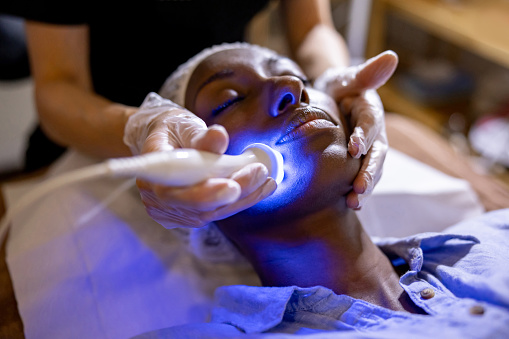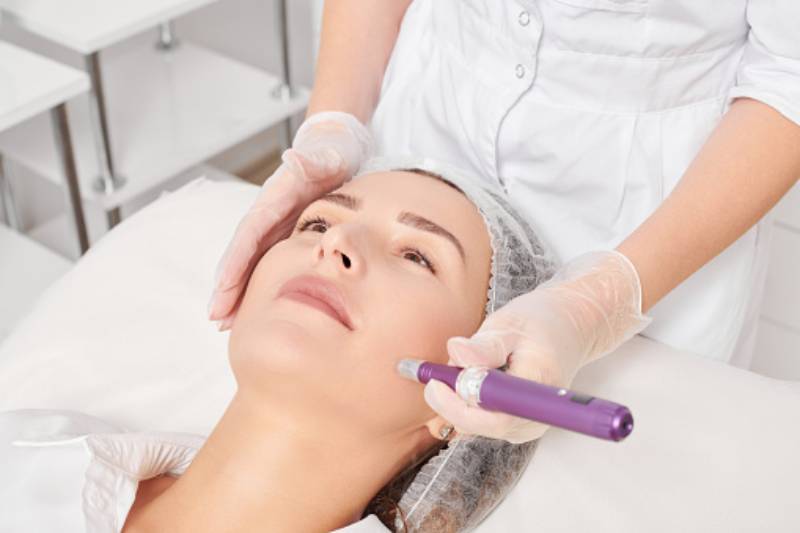Microneedling and laser skin resurfacing are both popular cosmetic procedures used to improve the appearance of the skin. Both treatments can help reduce the signs of aging, such as fine lines, wrinkles, and age spots, as well as improve the texture and tone of the skin. However, there are some key differences between these two procedures that may make one more suitable for your individual needs.
Microneedling involves using a handheld device with small needles that puncture the skin to stimulate the production of collagen and elastin. This helps to improve the overall texture and appearance of the skin, as well as reduce the appearance of scars and stretch marks. Microneedling is less invasive than laser skin resurfacing, which means that it typically has a shorter recovery time and less risk of side effects.
Laser skin resurfacing, on the other hand, involves using a laser to remove the top layer of skin and stimulate collagen production. This treatment is more invasive than microneedling and can cause some redness, swelling, and peeling of the skin. However, laser skin resurfacing can be more effective at treating deeper wrinkles, acne scars, and other more severe skin concerns.
Ultimately, the choice between microneedling and laser skin resurfacing will depend on your individual needs and goals. If you have mild to moderate signs of aging and are looking for a less invasive treatment with a shorter recovery time, microneedling may be a good option for you. However, if you have more severe skin concerns and are willing to undergo a more invasive procedure with a longer recovery time, laser skin resurfacing may be more appropriate. It is important to consult with a qualified cosmetic professional to determine which treatment is best for you.
Pros and cons of microneedling treatments?
Microneedling is a minimally invasive cosmetic procedure that involves puncturing the skin with tiny needles to stimulate collagen production and improve the overall texture and appearance of the skin. Like any cosmetic treatment, there are both pros and cons to microneedling that you should consider before deciding if it is right for you.

Pros of Microneedling:
- Improved Skin Texture: Microneedling can help improve the texture and tone of the skin, reducing the appearance of fine lines, wrinkles, and scars.
- Non-Invasive: Microneedling is less invasive than many other cosmetic procedures, which means that it typically has a shorter recovery time and less risk of side effects.
- Can Be Combined with Other Treatments: Microneedling can be combined with other treatments, such as serums and skin peels, to enhance its effects.
- Safe for All Skin Types: Microneedling is safe for all skin types, including those with sensitive skin.
- Long-Term Results: Microneedling stimulates the production of collagen and elastin, which means that the results can last for several months.
- Not Suitable for Severe Skin Issues: Microneedling is not recommended for severe skin issues such as deep wrinkles, scars, or hyperpigmentation.
- Temporary Redness and Swelling: After a microneedling treatment, the skin may be red and swollen for a few days, which can be uncomfortable.
- Risk of Infection: Microneedling involves puncturing the skin, which means that there is a risk of infection if proper sanitation procedures are not followed.
- Multiple Treatments May Be Required: To achieve optimal results, multiple microneedling treatments may be required, which can be time-consuming and costly.
- Can Be Painful: Some people may find microneedling to be uncomfortable or painful, although a numbing cream can be applied to the skin beforehand to minimize discomfort.
It is important to discuss any concerns or questions you may have about microneedling with a qualified cosmetic professional before undergoing the procedure.
Pros and cons of laser resurfacing?
Laser skin resurfacing is a cosmetic procedure that uses laser technology to remove the top layer of skin, which stimulates collagen production and can improve the overall texture and appearance of the skin. Like any cosmetic treatment, there are both pros and cons to laser resurfacing that you should consider before deciding if it is right for you.

- Improved Skin Texture: Laser resurfacing can help improve the texture and tone of the skin, reducing the appearance of fine lines, wrinkles, and scars.
- More Effective: Laser resurfacing is generally more effective at treating deeper wrinkles, scars, and other more severe skin concerns than other non-invasive treatments.
- Long-Lasting Results: The results of laser resurfacing can last for several years, making it a worthwhile investment for many people.
- Customizable: Laser resurfacing can be customized to address specific concerns and areas of the skin, which makes it a versatile treatment option.
- Stimulates Collagen Production: Laser resurfacing stimulates the production of collagen and elastin, which can improve the overall health and appearance of the skin.
Cons of Laser Resurfacing:
- Invasive: Laser resurfacing is a more invasive procedure than other non-invasive treatments, which means that it can be more uncomfortable and require a longer recovery time.
- Risk of Side Effects: Laser resurfacing can cause redness, swelling, and peeling of the skin, as well as other side effects such as scarring and infection.
- Not Suitable for All Skin Types: Laser resurfacing may not be suitable for all skin types, particularly those with darker skin tones.
- Expensive: Laser resurfacing is a relatively expensive procedure, which may not be accessible to everyone.
- Requires Downtime: After a laser resurfacing treatment, you will need to take some time off work and avoid certain activities to allow your skin to heal properly.
It is important to discuss any concerns or questions you may have about laser resurfacing with a qualified cosmetic professional before undergoing the procedure. They can help you determine if laser resurfacing is the right treatment option for you based on your individual needs and goals.
Can they be used effectively together?
Yes, microneedling and laser resurfacing can be used effectively together to enhance the overall results. In fact, many cosmetic professionals recommend combining the two treatments to achieve optimal results.
Microneedling can help prepare the skin for laser resurfacing by improving the texture and tone of the skin, making it more receptive to the laser treatment. It can also help reduce the appearance of fine lines and wrinkles, which can be further improved with laser resurfacing.
After a laser resurfacing treatment, microneedling can be used to help stimulate collagen production and enhance the overall results. The combination of the two treatments can help improve the overall texture and appearance of the skin, reduce the appearance of fine lines and wrinkles, and improve the overall health of the skin.
However, it is important to note that the combination of microneedling and laser resurfacing may not be suitable for everyone. It is important to discuss your individual needs and goals with a qualified cosmetic professional to determine if this combination is right for you.
What is the best resurfacing treatment for skin?
